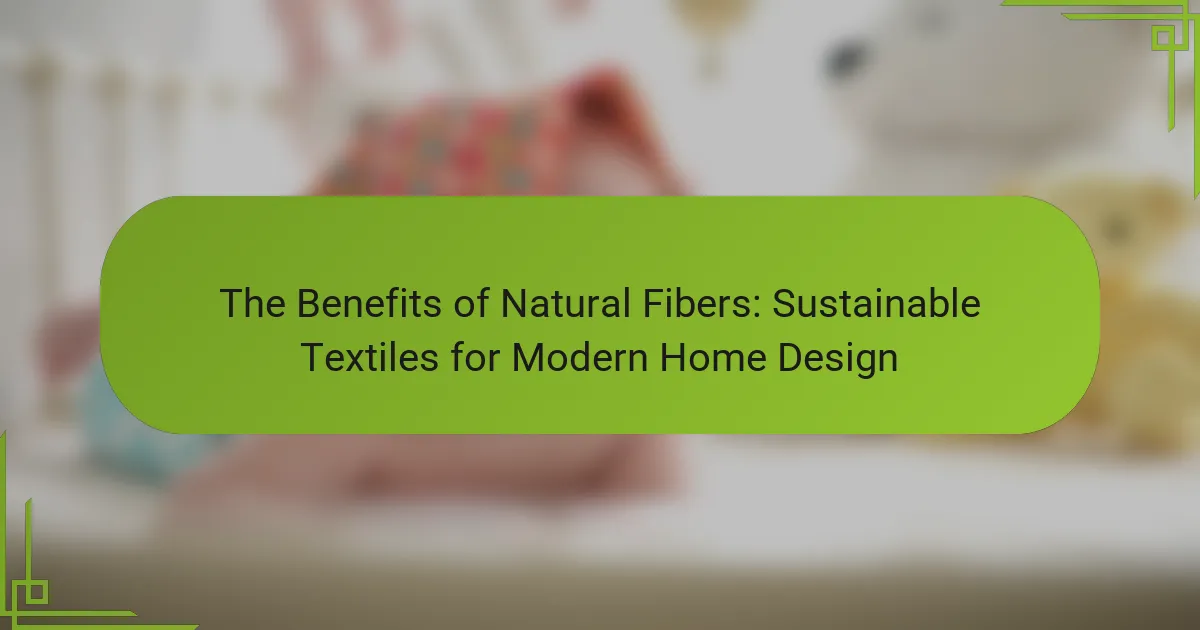
What are Natural Fibers and Their Role in Sustainable Textiles?
Natural fibers are materials obtained from plants, animals, or minerals. They include cotton, wool, silk, and linen. Natural fibers play a significant role in sustainable textiles. They are biodegradable and have a lower environmental impact compared to synthetic fibers. The production of natural fibers often requires less energy and fewer chemicals. For instance, organic cotton is grown without harmful pesticides. This reduces soil and water pollution. Additionally, natural fibers can be recycled and reused. Their versatility allows for various applications in home design. Sustainable textiles made from natural fibers contribute to eco-friendly living.
How do natural fibers differ from synthetic fibers?
Natural fibers are derived from plants, animals, or minerals, while synthetic fibers are man-made from chemical processes. Natural fibers include cotton, wool, and silk. They are biodegradable and often considered more environmentally friendly. Synthetic fibers include polyester, nylon, and acrylic. They are durable and resistant to moisture and mildew. Natural fibers tend to be more breathable and comfortable against the skin. Synthetic fibers can be engineered for specific properties like stretch and strength. According to the Environmental Protection Agency, natural fibers decompose more easily than synthetic options. This makes natural fibers a sustainable choice for home design.
What are the key characteristics of natural fibers?
Natural fibers are derived from plants, animals, or minerals. They possess several key characteristics. Natural fibers are biodegradable, making them environmentally friendly. They are breathable, allowing air to circulate, which enhances comfort. Natural fibers also have moisture-wicking properties, helping to absorb and release moisture. Additionally, they are generally hypoallergenic, reducing the risk of allergic reactions. Durability varies among natural fibers, with some being stronger than others. Natural fibers can be dyed easily, allowing for a wide range of colors. Lastly, they often provide excellent insulation, helping to regulate temperature.
Why are natural fibers considered sustainable?
Natural fibers are considered sustainable due to their biodegradable nature. They decompose naturally, reducing landfill waste. Unlike synthetic fibers, natural fibers require less energy to produce. They are often sourced from renewable resources, such as plants and animals. This sourcing minimizes environmental impact. Additionally, many natural fibers can be cultivated using organic farming practices. This approach reduces chemical usage and promotes biodiversity. The production of natural fibers also typically results in lower carbon emissions compared to synthetic alternatives. Overall, these factors contribute to the sustainability of natural fibers in textile production.
What types of natural fibers are commonly used in textiles?
Cotton, linen, wool, silk, and hemp are commonly used natural fibers in textiles. Cotton is known for its softness and breathability. Linen is valued for its durability and moisture-wicking properties. Wool provides insulation and is naturally flame-resistant. Silk is prized for its luxurious feel and sheen. Hemp is recognized for its strength and eco-friendliness. These fibers are widely utilized in various textile applications, including clothing, upholstery, and home decor.
What are the most popular natural fibers for home design?
The most popular natural fibers for home design include cotton, linen, wool, jute, and hemp. Cotton is widely used for its softness and versatility. Linen, made from flax, is known for its durability and breathability. Wool offers warmth and resilience, making it ideal for rugs and upholstery. Jute is appreciated for its eco-friendliness and rustic texture, often used in rugs and curtains. Hemp is valued for its strength and sustainability, suitable for various applications. These fibers are favored for their aesthetic appeal and environmental benefits.
How do different natural fibers impact the environment?
Different natural fibers impact the environment in various ways. Cotton requires significant water and pesticide use, leading to environmental degradation. In contrast, hemp grows quickly and needs minimal resources, making it more sustainable. Wool is biodegradable but can contribute to methane emissions from sheep. Linen, derived from flax, uses fewer chemicals and water, making it an eco-friendly option. Bamboo grows rapidly and absorbs carbon dioxide, but processing can involve harmful chemicals. Each fiber’s cultivation and processing methods determine its overall environmental footprint. Sustainable practices can mitigate negative impacts, enhancing their eco-friendliness.

What are the Benefits of Using Natural Fibers in Home Design?
Natural fibers in home design provide sustainability, aesthetic appeal, and health benefits. They are biodegradable and renewable, reducing environmental impact. Natural fibers, such as cotton, wool, and jute, offer unique textures and colors. These materials enhance indoor air quality by reducing allergens. Additionally, they provide thermal insulation, improving energy efficiency. Studies show that homes with natural fibers have lower carbon footprints. The use of natural fibers supports local economies and craftsmanship. Overall, incorporating natural fibers leads to a healthier and more sustainable living environment.
How do natural fibers contribute to indoor air quality?
Natural fibers contribute to indoor air quality by absorbing and releasing moisture. This process helps regulate humidity levels in indoor environments. Improved humidity control can reduce the growth of mold and dust mites. Natural fibers also have the ability to trap airborne pollutants. These include volatile organic compounds (VOCs) and particulate matter. Studies show that materials like cotton and wool can filter these pollutants effectively. For example, wool can absorb up to 30% of its weight in moisture without feeling wet. This moisture management contributes to a healthier indoor atmosphere. Overall, natural fibers enhance indoor air quality through moisture regulation and pollutant absorption.
What specific properties of natural fibers enhance air quality?
Natural fibers enhance air quality through their ability to absorb moisture and volatile organic compounds (VOCs). These fibers, such as cotton, wool, and hemp, can regulate humidity levels indoors. By absorbing excess moisture, they prevent mold growth, which can negatively impact air quality. Natural fibers also trap and neutralize VOCs, reducing harmful emissions in enclosed spaces. Research shows that materials like wool can absorb up to 30% of their weight in moisture without feeling damp. This property contributes to a healthier indoor environment. Additionally, natural fibers are biodegradable, reducing environmental impact compared to synthetic materials.
Why is indoor air quality important for health?
Indoor air quality is crucial for health because it directly impacts respiratory function and overall well-being. Poor indoor air quality can lead to health issues such as asthma, allergies, and other respiratory diseases. According to the World Health Organization, indoor air pollution is responsible for around 4.3 million premature deaths globally each year. Common pollutants include volatile organic compounds, mold, and particulate matter. These contaminants can originate from household products, building materials, and inadequate ventilation. Maintaining good indoor air quality can improve cognitive function and productivity. Studies show that better air quality can enhance overall quality of life and reduce healthcare costs.
What are the aesthetic advantages of natural fibers in home decor?
Natural fibers in home decor offer several aesthetic advantages. They provide a warm and inviting texture that enhances the overall ambiance of a space. Natural fibers, such as cotton, linen, and wool, exhibit a unique, organic beauty. This beauty stems from their inherent variations and imperfections, which add character to decor items. Additionally, natural fibers often feature earthy tones and colors that seamlessly blend with various design styles. Their versatility allows for creative applications, from upholstery to rugs and curtains. Furthermore, natural fibers are biodegradable, contributing to an eco-friendly aesthetic. Overall, these attributes create a harmonious and stylish environment in modern home design.
How do natural fibers influence the overall design aesthetic?
Natural fibers significantly enhance the overall design aesthetic by adding texture and warmth. These materials, such as cotton, linen, and wool, create a more inviting environment. Their organic appearance contributes to a sense of authenticity in design. Natural fibers often exhibit unique variations in color and pattern, which adds visual interest. This uniqueness allows for personalized design choices that reflect individual style. Additionally, natural fibers are often associated with sustainability, appealing to eco-conscious consumers. Their use in modern home design promotes a connection to nature, fostering a calming atmosphere. Research shows that spaces with natural materials can improve well-being and comfort, reinforcing their aesthetic value.
What textures and colors do natural fibers offer?
Natural fibers offer a wide range of textures and colors. Common textures include smooth, coarse, soft, and rough. Each texture provides a unique tactile experience. For example, cotton is soft and smooth, while jute is coarse and rough.
In terms of colors, natural fibers can be found in various shades. They often exhibit earthy tones like beige, brown, and green. Additionally, they can be dyed in vibrant colors. The dyeing process allows for a broad spectrum of hues.
The versatility in textures and colors contributes to their popularity in home design. This adaptability makes natural fibers suitable for various aesthetic preferences.

How Can You Incorporate Natural Fibers into Modern Home Design?
Incorporating natural fibers into modern home design can be achieved through various methods. Use natural fiber textiles for upholstery and curtains. Materials like cotton, linen, and wool add texture and warmth. Choose rugs made from jute or sisal for an organic touch. Implement natural fiber wall coverings for a unique aesthetic. Consider furniture pieces crafted from rattan or bamboo for sustainability. Integrate accessories like cushions and throws made from hemp or organic cotton. These choices promote eco-friendliness and enhance interior comfort. Natural fibers are biodegradable, making them a sustainable option for home design.
What are some practical applications of natural fibers in home interiors?
Natural fibers have several practical applications in home interiors. They are commonly used in upholstery for furniture, providing durability and comfort. Natural fiber rugs, such as jute and sisal, add texture and warmth to spaces. Curtains made from cotton or linen enhance light filtration while maintaining a natural aesthetic. Wall coverings made from bamboo or hemp offer eco-friendly alternatives to traditional materials. Bedding made from organic cotton promotes better sleep quality due to breathability. Natural fiber cushions and throws add coziness and style to living areas. These applications contribute to a sustainable home environment, aligning with modern design principles.
Which natural fiber products are ideal for living spaces?
Natural fiber products ideal for living spaces include jute rugs, cotton curtains, and wool upholstery. Jute rugs are durable and biodegradable, making them eco-friendly. Cotton curtains provide good insulation and are easy to clean. Wool upholstery is naturally fire-resistant and adds warmth. Linen bedding is breathable and moisture-wicking, enhancing comfort. Sisal mats are strong and suitable for high-traffic areas. Bamboo furniture is lightweight and sustainable, offering a modern aesthetic. These products contribute to a healthy indoor environment while promoting sustainability.
How can natural fibers be used in furniture and upholstery?
Natural fibers can be used in furniture and upholstery for their durability and aesthetic appeal. Common natural fibers include cotton, linen, jute, and wool. These materials provide breathable and comfortable surfaces. They are also biodegradable, making them environmentally friendly. Natural fibers can be woven into various textures and patterns. This versatility allows for a range of design options. Additionally, they often have hypoallergenic properties, enhancing indoor air quality. The use of natural fibers in furniture contributes to sustainable design practices.
What tips should you consider when choosing natural fiber textiles?
When choosing natural fiber textiles, consider the fiber type, such as cotton, linen, or wool. Each fiber has distinct properties. Cotton is soft and breathable. Linen is strong and moisture-wicking. Wool is warm and resilient. Assess the textile’s durability based on usage. For high-traffic areas, opt for sturdier fibers. Check for certifications like GOTS or OEKO-TEX. These ensure organic or non-toxic production methods. Evaluate the maintenance requirements of the textile. Some natural fibers may require special care. Lastly, consider the environmental impact. Sustainable sourcing reduces ecological footprints.
How do you select the right natural fiber for your needs?
To select the right natural fiber for your needs, identify the specific application and desired characteristics. Consider the fiber’s durability, softness, and breathability. For upholstery, choose strong fibers like cotton or linen. For clothing, prioritize softness and comfort, which are found in cotton or bamboo. Evaluate the environmental impact of the fiber, as sustainability is essential in modern design. Research the care requirements; some fibers may need special washing or maintenance. Finally, test samples to assess feel and performance before making a decision.
What maintenance practices are necessary for natural fiber textiles?
Natural fiber textiles require specific maintenance practices to ensure longevity and appearance. Regular cleaning is essential; it typically involves gentle washing with mild detergents. Avoid harsh chemicals that can damage fibers. Air drying is preferred over machine drying to prevent shrinkage. Storing textiles in a cool, dry place protects them from moisture and pests. Regularly rotating and fluffing items can maintain their shape and texture. Using a soft brush can help remove dust without damaging the fibers. These practices help preserve the quality of natural fibers, which are often more delicate than synthetic options.
What are the future trends in natural fibers for home design?
Future trends in natural fibers for home design include increased use of sustainable materials. Designers are prioritizing eco-friendly options like organic cotton, hemp, and linen. These materials offer durability and biodegradability. Innovations in processing enhance the texture and appeal of natural fibers. The demand for versatile applications in upholstery and textiles is rising. Consumers favor aesthetics that reflect nature, promoting organic patterns and colors. Additionally, advancements in technology improve the accessibility of natural fibers. These trends align with a growing commitment to sustainability in the design industry.
How is technology impacting the use of natural fibers?
Technology is significantly enhancing the use of natural fibers in various industries. Innovations in processing techniques improve fiber extraction and quality. Advanced machinery increases efficiency in spinning and weaving natural fibers. Digital technologies enable precise design and customization of textile patterns. Sustainable practices are promoted through technology, reducing waste in production. Research shows that eco-friendly treatments enhance durability without compromising sustainability. For instance, enzymatic treatments improve the performance of cotton and linen. Overall, technology is transforming natural fibers into versatile, high-performance materials.
What innovations are emerging in sustainable textile design?
Innovations in sustainable textile design include the development of biodegradable fabrics. These fabrics decompose naturally, reducing environmental impact. Another innovation is the use of recycled materials. Brands are now creating textiles from post-consumer waste, such as plastic bottles. Additionally, advancements in dyeing processes are emerging. These processes utilize less water and non-toxic chemicals. Innovations also include plant-based fibers, which offer alternatives to synthetic textiles. Examples are fibers derived from hemp and organic cotton. Finally, 3D knitting technology is gaining traction. This technology minimizes waste by producing garments in a single step. These innovations collectively enhance sustainability in the textile industry.
How can you start integrating natural fibers into your home today?
Start integrating natural fibers into your home by selecting items made from materials like cotton, linen, jute, or hemp. These fibers are sustainable and biodegradable. Consider purchasing rugs, curtains, or upholstery that feature these materials. Incorporating natural fiber throw pillows or blankets can also enhance your decor. Look for furniture with natural fiber elements, such as wicker or rattan. You can even choose natural fiber baskets for storage solutions. These choices promote a healthier indoor environment. Studies show that natural fibers can improve air quality by reducing indoor pollutants.
Natural fibers, including cotton, wool, silk, and linen, are essential components of sustainable textiles, offering biodegradability and lower environmental impact compared to synthetic alternatives. This article explores the characteristics, benefits, and practical applications of natural fibers in modern home design, emphasizing their role in enhancing indoor air quality and promoting eco-friendly living. It also discusses the aesthetic advantages of natural fibers, their influence on design trends, and practical tips for incorporating these materials into home interiors. Additionally, the article highlights future innovations in sustainable textile design and the impact of technology on natural fiber use.
